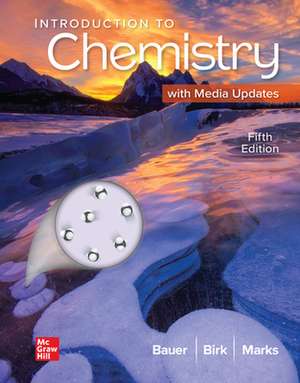Loose Leaf for Introduction to Chemistry
Autor Rich Bauer, James Birk, Pamela S. Marksen Limba Engleză Foi volante – vârsta de la 18 până la 22 ani
- Reformatted Examples and Practice Problems provide a "read-a-little, do-a-little" approach for students, breaking difficult concepts down into accessible portions.
- Concept Review questions are now auto-graded and integrated into the eBook, providing immediate feedback for students as they test their knowledge of the chapter.
>Introduction to Chemistry, Fifth edition takes a conceptual approach to introductory chemistry. Chapters open with a scenario involving real-life students to connect abstract chemical concepts to students' lives. Math is introduced on a need-to-know basis. This conceptual approach first teaches the chemistry and then shows students how to use the math with the chemistry. We recognize how important it is for students to apply chemistry to their world and have added or expanded applications - especially medical- and environment-related applications - throughout the text, marginal notes, worked examples, and end-of-chapter problems. -Consider This features offer conceptual-in-nature questions at the end of worked examples. These questions prompt students to extend their understanding beyond the focus of the worked examples.
-Key Concepts replace end-of-chapter summaries. Presented in outline form, they guide student discovery of the most important ideas discussed in each chapter.
-Concept Review multiple-choice questions have been added to end-of-chapter questions and problems. Because most students in an introductory chemistry course will take multiple-choice exams, these questions provide them with an outstanding practice opportunity. The conceptual nature of these questions helps students develop deeper understanding and critical thinking skills. After each question, a follow-up question provides additional practice with the analysis of multiple-choice responses.
-Four new elements have been named in the Revised Periodic Table: nihonium (Nh, element 113), moscovium (Mc, 115), tennessine (Ts, 117), and oganesson (Og, 118).
-The Art Program is considered the best in the market. To help students connect verbal descriptions to molecular-level representations, the program uses symbols and zoomed-in art to show critical phenomena at a molecular level.
>The best approach to incorporating math involves development of associated math on an as-needed basis, with an emphasis on concepts that the problems are trying to illustrate. This text integrates need-to-know mathematical ideas that are important to chemists into conceptual discussions.
-Math Toolboxes have been reworked and expanded, and now include accompanying end-of-chapter problems.
-Toolbox Icons in the text margins point students to the appropriate review material.
>
Preț: 698.37 lei
Preț vechi: 821.60 lei
-15% Nou
Puncte Express: 1048
Preț estimativ în valută:
133.64€ • 140.92$ • 111.25£
133.64€ • 140.92$ • 111.25£
Carte indisponibilă temporar
Doresc să fiu notificat când acest titlu va fi disponibil:
Se trimite...
Preluare comenzi: 021 569.72.76
Specificații
ISBN-13: 9781260162097
ISBN-10: 1260162095
Pagini: 832
Greutate: 1.41 kg
Ediția:5
ISBN-10: 1260162095
Pagini: 832
Greutate: 1.41 kg
Ediția:5
Notă biografică
Richard Bauer completed his B.S. in chemistry at Saginaw Valley State University (Michigan) and his M.A. and Ph.D. in chemistry education at Purdue University. He is currently the faculty head for science, mathematics, and social science at the Downtown Phoenix Campus of Arizona State University. As general chemistry coordinator on the Tempe campus, Dr. Bauer implemented an inquiry-based laboratory program. He has taught introductory and general chemistry courses for more than 25 years as well as a methods of chemistry teaching course. Dr. Bauer enjoys the diversity of students enrolled in introductory chemistry and is interested in student visualization of abstract, molecular-level concepts; teaching assistant training; and methods of secondary-school chemistry teaching.
